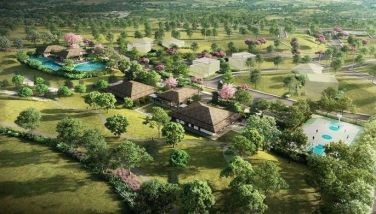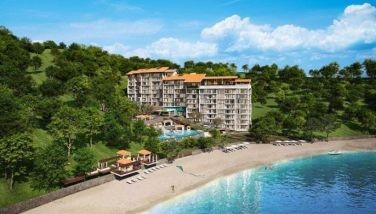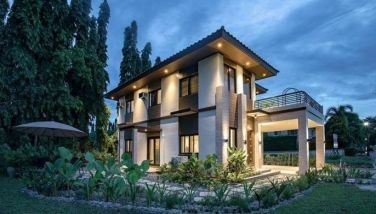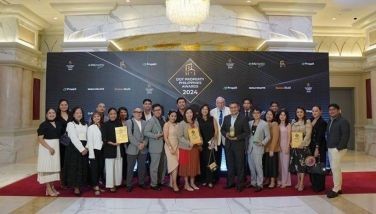Perseverance is the key
July 4, 2004 | 12:00am
"Kung May Tiyaga, May Nilaga." This more or less sums up the experience of the African Daisy Fisherfolk Association (ADFA).
Given the name of the group, one may be inclined to think that they are into ornamental growing, or perhaps they are a group of elderly ladies dabbling into cutflower production. The association is actually composed of fisherfolk from the coastal barangay of Bignay Dos, Sariaya in Quezon. The group ventured into cage culture of bangus (milkfish) and is now into grouper culture, more popularly known as lapulapu.
Organized in December 1994, ADFA is one of the groups being assisted by the Bureau of Fisheries and Aquatic Resources — Fisheries Resource Management Project (BFAR-FRMP) through its Enterprise Development Program.
The FRMP is a six-year undertaking of DA-BFAR with funding from the Asian Development Bank (ADB) and the Japan Bank for International Cooperation (JBIC). Its two-pronged objectives are to reverse the trend in fishery resource depletion and alleviate country’s subsistence fishermen from widespread poverty.
ADFA’s cage culture of bangus started in August 2002 after their members were trained by BFAR Region IV-A under regional director Rosa Macas and project implementation unit head, assistant regional director Esmeralda Manalang.
Their initial stock consisted of 3,500 bangus fingerlings in three 6x9 meter cages. BFAR-FRMP provided ADFA with nets, strings, fingerlings and feeds. As its counterpart, the local government unit (LGU) of Sariaya contributed the food of the laborers during the construction of the cages. ADFA provided the needed labor and some bamboo poles.
The first harvest was made in December 2002, four months after the project started. Technology-wise, the project was considered a success given an 80 percent survival rate. However, due to the low market price of bangus, the group was not able to recover its initial investment.
Despite this loss, ADFA did not lose hope. The members persevered. They tried shifting to grouper culture. "We have nothing to lose but our sweat and a small part of our time, but everything to gain if we succeed," said ADFA president Jose Asardon.
ADFA used the proceeds from the first production cycle to maintain one cage for bangus culture while three cages were devoted for grouper culture. One of the three cages for grouper was lent out to ADFA for free by Asardon. Aside from technical assistance, the LGU of Sariaya provided an additional P25,000 to augment the capital of the organization for the grouper culture.
The group decided to change most of their stocks to grouper since it is higher priced. In addition, the size of the fish cages and the chosen site are ideal for grouper culture because of the right depth and salinity, protective cove and mangroves. The site was actually recommended for joint mariculture development by ADFA, LGU and BFAR.
Two hundred sixty-three grouper fingerlings were initially stocked in the fish cages. Some of these have been sold at P370 per kilo. Gross sales was P15,010 resulting in a net income of P4,500. The amount could have been more than double if not for the "disappearance" of some harvestable stocks, said to be stolen from the cages. As of May, 71 groupers from the initial stocks plus another 260 groupers from the second stocking were still in the cages ready for marketing. With 80 to 90 percent survival rate and at two pieces of grouper per kilo, ADFA is expected to gross P50,000 to P65,000 from the sale of the grouper stocks. Expected net income is P25,000 to P40,000, excluding labor, depreciation and maintenance cost of the fish cages. The culture of grouper fingerlings takes about four months.
Instead of distributing dividends to the members, income will be retained for expansion until the project is large enough to earn a sizeable profit that will be distributed to members. ADFA has 43 members, two-thirds of which are female with 25 active members.
Armed with mature production technology and lucrative market, together with the active involvement and commitment of ADFA members, and in partnership with BFAR-FRMP and the LGU of Sariaya, the grouper cage culture project offers promising future for the members and its communities.
Given the name of the group, one may be inclined to think that they are into ornamental growing, or perhaps they are a group of elderly ladies dabbling into cutflower production. The association is actually composed of fisherfolk from the coastal barangay of Bignay Dos, Sariaya in Quezon. The group ventured into cage culture of bangus (milkfish) and is now into grouper culture, more popularly known as lapulapu.
Organized in December 1994, ADFA is one of the groups being assisted by the Bureau of Fisheries and Aquatic Resources — Fisheries Resource Management Project (BFAR-FRMP) through its Enterprise Development Program.
The FRMP is a six-year undertaking of DA-BFAR with funding from the Asian Development Bank (ADB) and the Japan Bank for International Cooperation (JBIC). Its two-pronged objectives are to reverse the trend in fishery resource depletion and alleviate country’s subsistence fishermen from widespread poverty.
ADFA’s cage culture of bangus started in August 2002 after their members were trained by BFAR Region IV-A under regional director Rosa Macas and project implementation unit head, assistant regional director Esmeralda Manalang.
Their initial stock consisted of 3,500 bangus fingerlings in three 6x9 meter cages. BFAR-FRMP provided ADFA with nets, strings, fingerlings and feeds. As its counterpart, the local government unit (LGU) of Sariaya contributed the food of the laborers during the construction of the cages. ADFA provided the needed labor and some bamboo poles.
The first harvest was made in December 2002, four months after the project started. Technology-wise, the project was considered a success given an 80 percent survival rate. However, due to the low market price of bangus, the group was not able to recover its initial investment.
Despite this loss, ADFA did not lose hope. The members persevered. They tried shifting to grouper culture. "We have nothing to lose but our sweat and a small part of our time, but everything to gain if we succeed," said ADFA president Jose Asardon.
ADFA used the proceeds from the first production cycle to maintain one cage for bangus culture while three cages were devoted for grouper culture. One of the three cages for grouper was lent out to ADFA for free by Asardon. Aside from technical assistance, the LGU of Sariaya provided an additional P25,000 to augment the capital of the organization for the grouper culture.
The group decided to change most of their stocks to grouper since it is higher priced. In addition, the size of the fish cages and the chosen site are ideal for grouper culture because of the right depth and salinity, protective cove and mangroves. The site was actually recommended for joint mariculture development by ADFA, LGU and BFAR.
Two hundred sixty-three grouper fingerlings were initially stocked in the fish cages. Some of these have been sold at P370 per kilo. Gross sales was P15,010 resulting in a net income of P4,500. The amount could have been more than double if not for the "disappearance" of some harvestable stocks, said to be stolen from the cages. As of May, 71 groupers from the initial stocks plus another 260 groupers from the second stocking were still in the cages ready for marketing. With 80 to 90 percent survival rate and at two pieces of grouper per kilo, ADFA is expected to gross P50,000 to P65,000 from the sale of the grouper stocks. Expected net income is P25,000 to P40,000, excluding labor, depreciation and maintenance cost of the fish cages. The culture of grouper fingerlings takes about four months.
Instead of distributing dividends to the members, income will be retained for expansion until the project is large enough to earn a sizeable profit that will be distributed to members. ADFA has 43 members, two-thirds of which are female with 25 active members.
Armed with mature production technology and lucrative market, together with the active involvement and commitment of ADFA members, and in partnership with BFAR-FRMP and the LGU of Sariaya, the grouper cage culture project offers promising future for the members and its communities.
BrandSpace Articles
<
>
- Latest
Latest
Latest
October 23, 2024 - 9:30am
By May Dedicatoria | October 23, 2024 - 9:30am
October 11, 2024 - 3:45pm
October 11, 2024 - 3:45pm
October 10, 2024 - 11:30am
October 10, 2024 - 11:30am
October 5, 2024 - 12:08pm
October 5, 2024 - 12:08pm
September 24, 2024 - 1:00pm
September 24, 2024 - 1:00pm
September 13, 2024 - 4:00pm
September 13, 2024 - 4:00pm
Recommended
January 7, 2025 - 12:00am



























